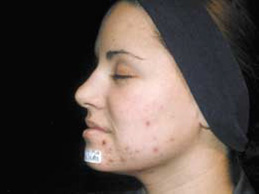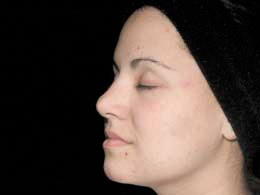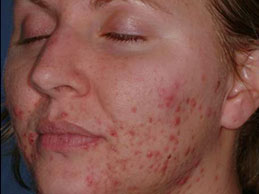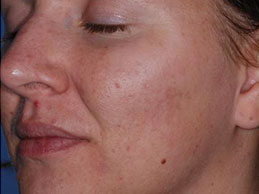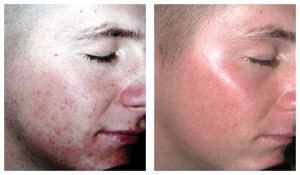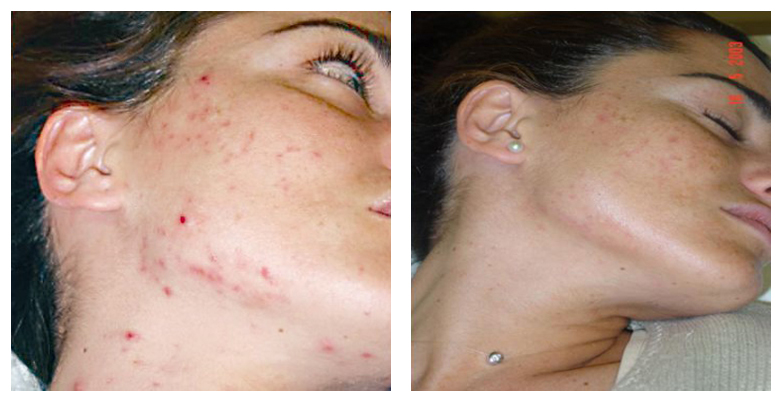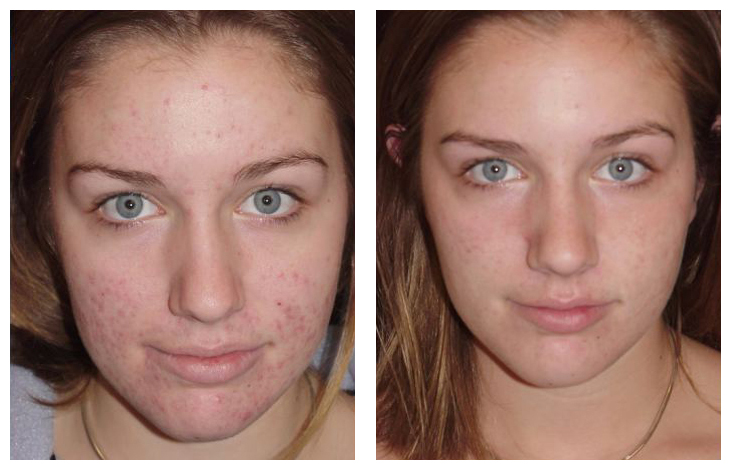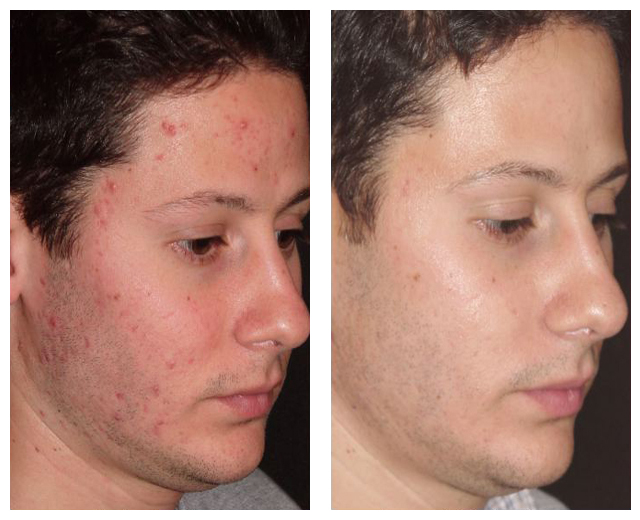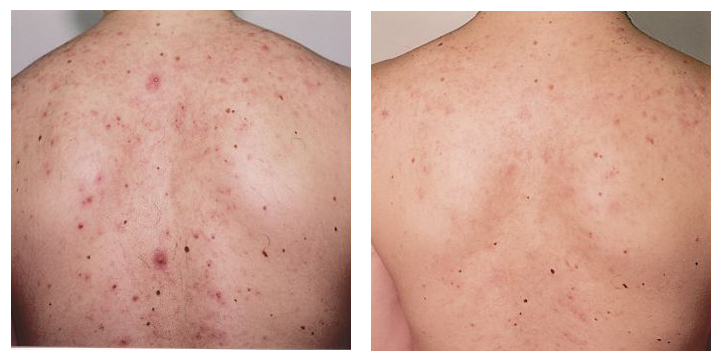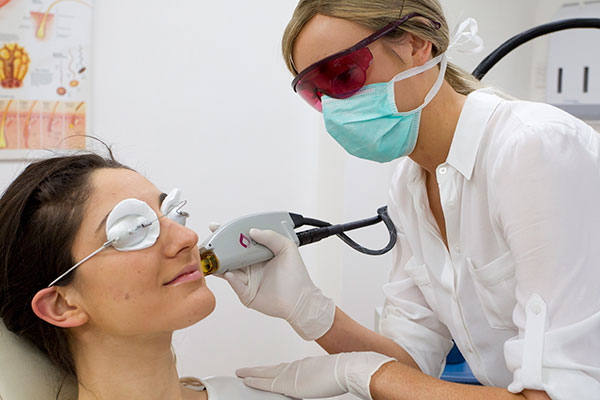Acne, also known as Acne Vulgaris, is a common inflammatory disorder of the sebaceous follicles. Acne is most common in adolescents, however can persist into adulthood, or can even begin in adulthood.
Acne most commonly occurs in areas of the skin where there is the greatest density of sebaceous follicles, including the face, neck, chest, back & shoulders.
Acne may present in the form of papules, pustules, comedones and nodules/cysts, and without adequate control, can progress into scarring.
Laser and light based treatments for active acne is revolutionising the treatment of this potentially debilitating disease. These laser treatments offer successful acne therapy and eliminating the need for drugs and their associated side effects.
What causes Acne?
What causes Acne?
There are several contributors towards the development of acne lesions:
- Overactive sebaceous glands: Sebum is the oil produced by the sebaceous gland, which is responsible for lubricating the skin surface. Androgenic hormones have the ability to stimulate sebum flow, and when excess sebum is produced it blocks the sebaceous duct. This is the reason it is common for acne flare-ups to occur during puberty and menstruation, when hormonal levels are high.
- Hyperkeratosis: In acne prone skin, the rate of skin cell production exceeds the desquamation rate (skin cell shedding), creating a build up of keratin (hardened dead skin cells). The dead skin cells, together with an increase in sebum flow, block the follicles, creating a plug or comedone. Hyperkeratosis may be attributed to a decline in lamellar granules, which are found in the stratum corneum (outer layer of skin) and responsible for releasing enzymes to digest the substance which holds skin cells together.
- Proliferation of Propionibacteria acnes: P. acnes are found on all skin types, however with acne-prone skin, there is an increased proliferation of bacteria. With the follicle trapped by excess sebum and dead skin cells, this creates an anaerobic environment, in which p. acnes bacteria thrive. The p. acnes bacteria digest the sebum, producing a fatty acid waste, causing irritation of the lining of the follicle and resultant inflammation.
Stages of Acne
Stages of Acne
There are several types of acne lesions which may progress in severity if left untreated, including:
- Open Acne comedones: Also known as blackheads, these are non-inflammatory lesions which develop when dead skin cells and sebum get trapped in an open follicle. The plug forms a black/brown appearance as it is oxidised with the exposure to oxygen.
- Closed Acne comedones: Are formed when dead skin cells and sebum become trapped within a closed follicle, and have the potential to develop into pustules, particularly if picked or squeezed.
- Pustules: Develop when there is a break in the follicle wall near the skin surface, which allows the invasion of white blood cells, forming a whitehead.
- Cysts: Occur when there is a break in the follicle wall deep within the skin, resulting in the leakage of dead skin cells, sebum and bacteria into the dermis. A membrane is formed around the infection, creating a palpable lump under the skin surface. This is the most progressive form of Acne, resulting in painful inflammation and irritation of the skin.
Aftermath of Acne
Aftermath of Acne
With persistent inflammatory acne there is often damage to the superficial capillaries, resulting in redness and poor skin complexion.
In darker skin types, there is also the risk of Post-inflammatory Hyperpigmentation (PIHP) whereby dark, patchy pigmentation develops as a result of persistent inflammation within the lower epidermis. This stimulates the melanocytes (pigmented cells), which act as a protective barrier to further trauma. This type of pigmentation resides deep within the epidermis, and may require a long-term treatment plan.
Acne Scarring
Acne Scarring
Atrophic acne scarring is often a consequence of long-term persistent inflammatory acne, whereby the tissue has been damaged. Atrophic Acne scars develop as a result of acne lesions, which have broken through the follicle wall into nearby tissue, creating inflammation and infection, and finally destroying collagen.
Atrophic Acne scarring may range in severity, from ice-pick scarring (small breaks in skin surface), to rolling and boxcar scarring (deeper and larger pitting).
Hypertrophic Acnescarring is a less common form of acne scarring, resulting from an over production of collagen. This appears as a hardened, raised lesion, and is often seen on areas of the body affected by acne.
DermaCare Treatments for Acne and Scarring
Excel V Laser Treatments
There are various treatment options available both to control acne breakouts as well as to improve the appearance of acne scarring.
A course of Laser Rejuvenation treatments may be useful to help control acne breakouts by killing the p.acnes bacteria and controlling sebum flow. Laser treatments may also help the improve the aftermath signs of acne, by minimising inflammation and redness, as well as stimulating collagen.
Chemical Peels
At DermaCare we offer various chemical peels for the treatment of acne breakouts and congestion, as well as to improve atrophic scarring. Upon consultation, the medical practitioner will devise a suitable treatment plan tailored to your skin condition and treatment goals.
The Detoxing Peel and Dermally Active Vitamin A Peel may be used to assist in the treatment of acne and congestion by regulating exfoliation, removing cellular debris and controlling sebum flow. Whilst the Resurfacing Peel and TCA Cross Peel are useful in the treatment of acne scarring, by softening the skin texture and improving the appearance of atrophic scarring.
Home Care
At DermaCare we believe in a wholistic approach to skin health, which is why we also support a daily home care regime, offering a medical skin care and mineral make-up range, as well as a selected range of practitioner only oral supplements.
Your medical practitioner will devise an individual medical skin care prescription tailored to your skin condition and treatment goals.
There are a few simple steps you can follow at home to help control acne breakouts & minimise scarring:
- Gentle daily exfoliation: important for removing cellular debris, bacteria and sebum, thereby decongesting the skin and minimising the occurrence of breakouts.
- Skin cell resurfacing: important for regulating the skin cell turnover cycle, minimising congestion, as well as stimulating dermal activity to help improve the appearance of acne scarring caused by collagen depletion.
- Daily protection: A light weight zinc-based moisturiser protects from environmental damage and offers anti-inflammatory benefits.

